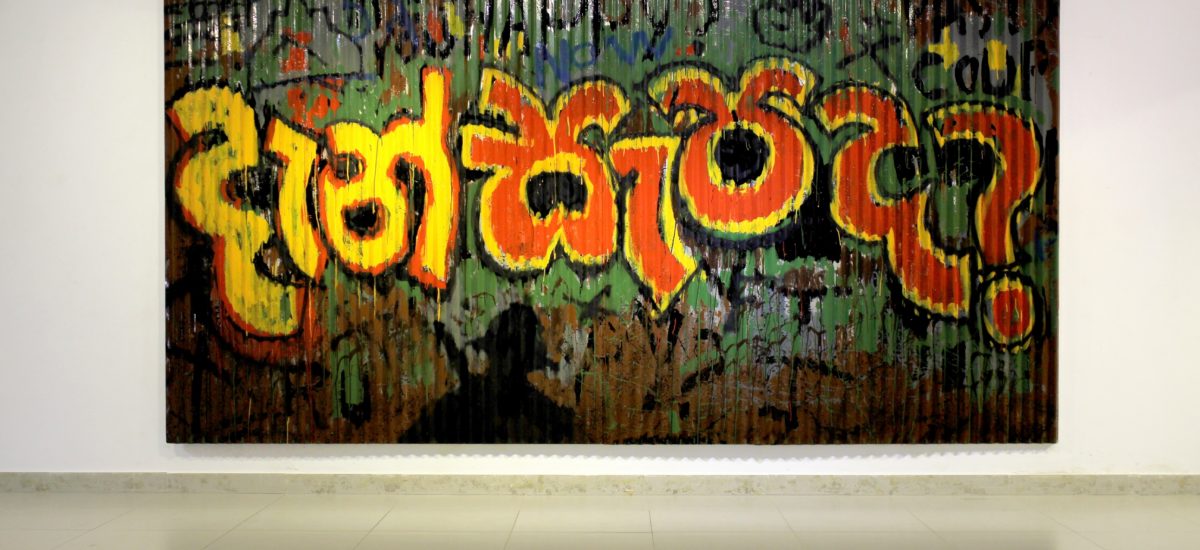For the past 22 years, activist and renowned contemporary artist Chandraguptha Thenuwara has been memorialising the horrific period of July 1983 through paintings, drawings, sculpture and installation. This year, undeterred by the Covid-19 pandemic that has disrupted every aspect of life, he has launched a virtual exhibition of his newest collection entitled “Atmosphere At/Most/Fear,” in collaboration with the Saskia Fernando Gallery.
It is not an extensive collection – just nine painting and a sculpture but, as they say, every picture tells a story.
The memoralisation works began with beginning with his famous Barrelism series in 1997.
After Sri Lanka entered war mode in 1983, security barriers sprung up across the country. In the beginning, they consisted of little more than sand-filled metal barrels strung across the road for the security forces to stop vehicles and conduct searches. They became a symbol of the irreversible changes that the country and society were going through.
At that time Thenuwara wrote, “With my barrels I seek to provoke people’s minds and raise civil consciousness to question the war and make them actively participate in the efforts to stop the war.” For him, the tar barrel was not an harmless object anymore. As used by the military, it symbolised state power and Sinhala racism. The barrels were often painted a vibrant yellow, designed to stand out and denote power, rather than to camouflage. “Thanks to the overwhelming presence of barrels, the government maintains its power over the masses. On the other hand, barrels provide security for the centres of power. I have tried to express this reality through the image of barrels,” he wrote.
Thenuwara continued to comment through his art on the compelling issues of the day, often inconvenient truths such as political violence, the disappeared, human rights, corruption, ethnicity and the misuse of power, that were not addressed by traditional communication sources. His exhibition in September last year was titled M.O.B, or Maliciously Organized Bastards, and was his interpretation of the chaotic political situation in the wake of Constitutional coup attempt in October 2018.
This year the focus is on militarisation as depicted in the shadow of a soldier, drawn sideways, repeated in different light and dark colours with one white on white painting. The soldier is everywhere but seems hidden on the fringes, so that we are lulled into a false sense of security, thinking that he is not actually present.
Another canvas shows a colourful row of medals such one would see on the shoulders of an army general, a reflection of Sri Lanka today where the military wields tremendous power, installed in every facet of life from historical monuments to agriculture and the hospitality industry.
The sculpture of the stocky soldier in riot gear suggests how people are silenced, often brutally, even when demonstrating peacefully. Just last month, protestors coming out in support of the Black Lives Matter movement were shoved roughly into police vans and hauled away. The man in the sculpture is faceless, with large hands and feet. His gear is melded to his body; his baton is poised to strike.
There is a white canvas. For the artist who uses colour widely, the contrasting white means peace. But in this canvas, blurred lines of smudged colour, sometimes red, creep through. It is a false peace, one that is tainted and unstable; it is not a just or sustainable peace.
Roofing sheets form the canvas for a huge painting with the words “Then Sapada?” or “Happy Now?”, perhaps a sarcastic reference to Prime Minister Mahinda Rajapaksa’s chant from 2015 to 2019, the years he was out of power after that astounding electoral defeat. Written like graffiti, the work is a reflection of nationalistic images and signs currently daubed on walls across the country. Along with colour, words play an important part in Thenuwara’s work, often with puns and double meanings, as is evident in the second part of the latest title “At/Most/Fear”.
“Thenuwara’s paintings are a testament to his dedication as an activist. People are often offended by his work and view him in a negative light but it is an honest documentation by an artist dedicated to his plight,” says his gallerist, Sasika Fernando.
Chandraguptha Thenuwara is a senior lecturer at the Faculty of Visual Arts. He founded the Vibhavi Academy of Fine Arts, an artist-run alternative art school. His work has been exhibited internationally in Australia, Asia and Europe. He is an active member of Purawesi Balaya (Citizens’ Power) organisation.
To view the online exhibition click here.
See an article on Chandraguptha Thenuwara’s Beautification and an interview with the artist on 70 Years of Independence carried out by Groundviews.

